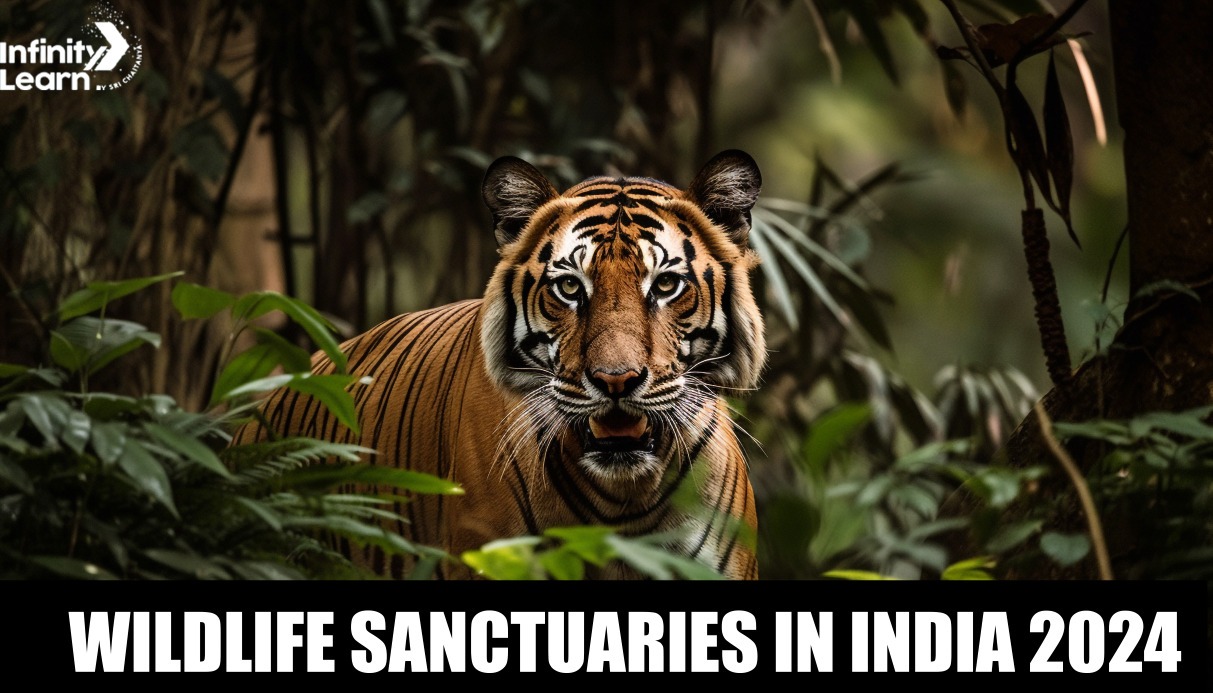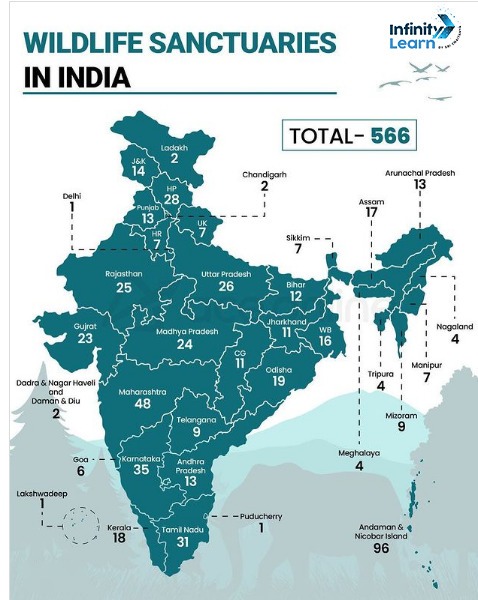Table of Contents
Wildlife Sanctuaries in India: India is home to a remarkable array of wildlife sanctuaries, each offering a sanctuary for diverse ecosystems and captivating creatures. With over 573 sanctuaries covering approximately 123,762.56 square kilometers, these protected areas constitute 3.76% of India’s vast geographical expanse. The Wildlife sanctuaries are vital for safeguarding endangered and endemic species, making them havens that attract nature enthusiasts and conservationists alike.
These sanctuaries play a crucial role in preserving India’s rich biodiversity, from the majestic Bengal tigers to vibrant bird species. Visitors can explore lush jungles, high mountains, and meandering rivers, experiencing nature at its finest. Wildlife sanctuaries in India are not just destinations but celebrations of nature’s wonders, offering unique opportunities to witness and appreciate the country’s diverse wildlife in their natural habitats.

Important Facts about Wildlife Sanctuaries in India 2024
- India currently has 573 Wildlife Sanctuaries covering 123,762.56 square kilometers, which is about 3.76% of the country’s land area (National Wildlife Database, Nov. 2023).
- An additional 218 Wildlife Sanctuaries are proposed, adding 16,829 square kilometers to the Protected Area Network.
- Vedanthangal Bird Sanctuary in Tamil Nadu, founded in 1796, holds the distinction of being India’s oldest bird sanctuary.
- The largest Wildlife Sanctuary in India is Hemis National Park in Ladakh, famous for its snow leopards and covering high-altitude terrain.
- Bor Tiger Reserve in Maharashtra is the smallest Wildlife Sanctuary, dedicated to protecting the endangered Bengal tiger.
- These sanctuaries are crucial for conserving India’s biodiversity, providing safe habitats for diverse species and contributing significantly to national conservation efforts.
Also Read: National Parks in India
Wildlife Sanctuaries in India Map

List of all Wildlife Sanctuaries in India 2024 Updated
Here’s the updated list of wildlife sanctuaries in India for 2024, presented in a tabular format:
| S.No. | State & UT | State Area (km²) | No. of WLS | Area (km²) | % of State Area |
| 1 | Meghalaya | 22429 | 4 | 94.11 | 0.42 |
| 2 | Jharkhand | 79714 | 11 | 1955.82 | 2.45 |
| 3 | Andaman & Nicobar | 8249 | 97 | 395.60 | 4.80 |
| 4 | Madhya Pradesh | 308245 | 24 | 7046.19 | 2.29 |
| 5 | Assam | 78438 | 17 | 1728.95 | 2.20 |
| 6 | Ladakh | 59146 | 2 | 9000.00 | 15.22 |
| 7 | Punjab | 50362 | 13 | 326.60 | 0.65 |
| 8 | Nagaland | 16579 | 4 | 43.91 | 0.26 |
| 9 | Goa | 3702 | 6 | 647.91 | 17.50 |
| 10 | Daman & Diu | 112 | 1 | 2.19 | 1.96 |
| 11 | Uttar Pradesh | 240928 | 26 | 5822.20 | 2.42 |
| 12 | Andhra Pradesh | 160229 | 13 | 6771.40 | 4.23 |
| 13 | Chhattisgarh | 135191 | 11 | 3760.28 | 2.78 |
| 14 | Lakshadweep | 32 | 1 | 0.01 | 0.03 |
| 15 | Odisha | 155707 | 19 | 7094.65 | 4.56 |
| 16 | Manipur | 22327 | 7 | 708.14 | 3.17 |
| 17 | Delhi | 1483 | 1 | 19.61 | 1.32 |
| 18 | Maharashtra | 307713 | 49 | 7861.70 | 2.55 |
| 19 | Uttarakhand | 53483 | 7 | 2690.12 | 5.03 |
| 20 | Kerala | 38863 | 18 | 2156.21 | 5.55 |
| 21 | Telangana | 114840 | 9 | 5672.70 | 4.94 |
| 22 | Tripura | 10486 | 4 | 603.64 | 5.76 |
| 23 | Gujarat | 196022 | 23 | 16618.42 | 8.48 |
| 24 | Haryana | 44212 | 7 | 118.21 | 0.27 |
| 25 | Tamil Nadu | 130058 | 33 | 7096.54 | 5.46 |
| 26 | Karnataka | 191791 | 38 | 8216.69 | 4.28 |
| 27 | Bihar | 94163 | 12 | 2851.67 | 3.03 |
| 28 | Rajasthan | 342239 | 25 | 5592.38 | 1.63 |
| 29 | Chandigarh | 114 | 2 | 26.01 | 22.82 |
| 30 | Mizoram | 21081 | 9 | 1359.75 | 6.45 |
| 31 | Arunachal Pradesh | 83743 | 13 | 7614.56 | 9.09 |
| 32 | West Bengal | 88752 | 16 | 1440.18 | 1.62 |
| 33 | Himachal Pradesh | 55673 | 28 | 6115.97 | 10.99 |
| 34 | Sikkim | 7096 | 7 | 399.10 | 5.62 |
| 35 | Jammu & Kashmir | 163090 | 14 | 1815.04 | 1.11 |
| 36 | Dadra & Nagar Haveli | 491 | 1 | 92.17 | 18.77 |
| 37 | Puducherry | 480 | 1 | 3.90 | 0.81 |
List of Wildlife Sanctuaries in Indian Union Territories (UTs)
Wildlife Sanctuaries in Union Territories (UTs) of India:
| S No. | UTs | Wildlife Sanctuary |
| 1. | Andaman and Nicobar Islands | Bamboo Island WLS |
| Barren Island WLS | ||
| Chanel Island WLS | ||
| Peacock Island WLS | ||
| Turtle Islands WLS | ||
| 2. | Jammu & Kashmir | Gulmarg WLS |
| Limber WLS | ||
| Nandini WLS | ||
| 3. | Lakshadweep | Pitti WLS (Bird) |
| 4. | Dadra Nagar Haveli and Daman and Diu | Dadra & Nagar Haveli WLS |
| Fudam WLS |
Note: WLS stands for Wildlife Sanctuary
Top 10 Wildlife Sanctuaries in India with their States
1. Jim Corbett National Park (Uttarakhand):
Oldest national park in India, known for Bengal tigers and elephants.
Located in the foothills of the Himalayas, offers diverse flora and fauna.
2. Ranthambore National Park (Rajasthan):
Famous for its population of Bengal tigers and historic Ranthambore Fort.
Located amidst the Aravalli and Vindhya ranges, known for tiger sightings.
3. Kaziranga National Park (Assam):
UNESCO World Heritage Site, home to the largest population of Indian one-horned rhinoceroses.
Located on the banks of the Brahmaputra River, also hosts tigers, elephants, and migratory birds.
4. Bandhavgarh National Park (Madhya Pradesh):
Known for its high density of Bengal tigers and ancient Bandhavgarh Fort.
Offers scenic landscapes of rocky hills, grasslands, and dense forests.
5. Gir National Park (Gujarat)
Sole habitat of the Asiatic lion in the wild.
Located in the Saurashtra peninsula, known for its dry deciduous forests and diverse wildlife.
6. Periyar National Park (Kerala)
Renowned for its thriving elephant population and the picturesque Periyar Lake.
Located in the Western Ghats, offers opportunities for wildlife safaris and boat cruises.
7. Sundarbans National Park (West Bengal)
The largest mangrove forest globally and a UNESCO World Heritage Site.
Home to Bengal tigers, saltwater crocodiles, and a unique ecosystem shaped by tides.
8. Sariska Tiger Reserve (Rajasthan)
Former hunting preserve of the royal family, now a sanctuary for Bengal tigers and other wildlife.
Located in the Aravalli range, known for its landscapes and historical ruins.
9. Hemis National Park (Ladakh, Jammu & Kashmir)
Largest national park in India, known for its population of snow leopards.
Located in the eastern part of Ladakh, offers high-altitude wildlife and stunning landscapes.
10. Keoladeo National Park (Rajasthan)
UNESCO World Heritage Site, known for its diverse bird population, especially during migratory season.
Located near Bharatpur, offers birdwatching and wetland conservation efforts.
Importance of Wildlife Sanctuaries in India
- Biodiversity Conservation: Wildlife sanctuaries in India play a crucial role in conserving the diverse flora and fauna of the country.
- Habitat Protection: They provide safe habitats for endangered and endemic species, helping to maintain ecological balance.
- Tourism and Education: These sanctuaries attract tourists and serve as centers for environmental education and research.
- Economic Benefits: Wildlife tourism generates revenue and provides livelihood opportunities for local communities.
- Preservation of Natural Heritage: They safeguard India’s natural heritage for future generations to enjoy and study.
- Climate Regulation: Sanctuaries contribute to climate regulation and carbon sequestration through preserved ecosystems.
- Cultural Significance: Many sanctuaries hold cultural and historical importance, connecting people with their natural surroundings.
| List of Other Topics | |
| List of US State Capitals | Most Populated States in India |
| 7 Continents and 5 Oceans | Union Territories of India |
| List of Places in India | Capital of Haryana |
| State Animals in India | Coldest Places in Inida |
| Top Universities in India | Scheduled Castes and Scheduled Tribes |
GK Questions on Wildlife Sanctuaries in India
Question 1: Which wildlife sanctuary in India is known as the sole habitat of the Asiatic lion in the wild?
Answer: Gir National Park, Gujarat.
Question 2: What is the name of the oldest bird sanctuary in India, established in 1796?
Answer: Vedanthangal Bird Sanctuary, Tamil Nadu.
Question 3: Which national park in India is renowned for its population of Indian one-horned rhinoceroses and is a UNESCO World Heritage Site?
Answer: Kaziranga National Park, Assam.
Question 4: In which state would you find the Bandipur National Park, known for its significant tiger population?
Answer: Karnataka.
Question 5: Which wildlife sanctuary in Rajasthan is famous for its population of Bengal tigers and the historic Ranthambore Fort?
Answer: Ranthambore National Park.
Question 6: Name the national park in Uttarakhand known for its diverse wildlife, including Bengal tigers and elephants, and as the oldest national park in India.
Answer: Jim Corbett National Park.
Question 7: Which wildlife sanctuary in Madhya Pradesh is renowned for having the highest density of Bengal tigers in India?
Answer: Bandhavgarh National Park.
Question 8: What is the name of the national park in Ladakh, Jammu & Kashmir, known for its population of snow leopards and being the largest national park in India?
Answer: Hemis National Park.
FAQs on Wildlife Sanctuaries in India
Which is the most famous wildlife sanctuary in India?
The most famous wildlife sanctuary in India is Jim Corbett National Park, located in Uttarakhand. It is renowned for being the oldest national park in India and for its Bengal tigers and diverse wildlife.
What are the 10 wildlife sanctuaries?
The top 10 wildlife sanctuaries in India include Jim Corbett National Park, Ranthambore National Park, Kaziranga National Park, Bandhavgarh National Park, Gir National Park, Periyar National Park, Sundarbans National Park, Sariska Tiger Reserve, Hemis National Park, and Keoladeo National Park.
How many total wildlife sanctuaries are there in India?
As of the latest count, there are 573 wildlife sanctuaries in India, covering approximately 123,762.56 square kilometers.
Which is the first wildlife sanctuary in India?
The first wildlife sanctuary in India is the Vedanthangal Bird Sanctuary in Tamil Nadu. It was established in 1796 and is known for its significant bird population, especially during migratory seasons.
Which state has largest wildlife sanctuary?
The state with the largest wildlife sanctuary in India is Madhya Pradesh. Bandhavgarh National Park, located in Madhya Pradesh, is known for its significant tiger population and covers a substantial area, making it one of the largest wildlife sanctuaries in the country.









